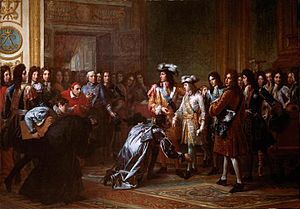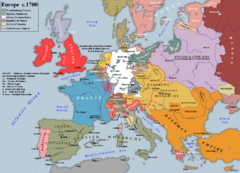Treaty of The Hague (1701) facts for kids
| Treaty of the Second Grand Alliance between Great Britain, Austria and the United Provinces | |
|---|---|

Proclamation of Philip of Anjou as Philip V of Spain, Versailles: 16 November 1700
|
|
| Context | Anti-French Alliance and the War of the Spanish Succession |
| Signed | 7 September 1701 |
| Location | The Hague |
| Parties | |
The Treaty of Den Haag, also known as the Treaty of The Hague, was signed on September 7, 1701. It was an agreement between England, the Holy Roman Emperor Leopold I (who ruled Austria), and the United Provinces (the Netherlands). This treaty brought back an earlier alliance against France, called the Grand Alliance. It was created to deal with problems that led to the big conflict known as the War of the Spanish Succession.
Contents
Why the Treaty Was Needed

The French King Louis XIV started many wars in the late 1600s. These wars made other European countries form groups against France. One important group was the Grand Alliance, formed in 1689. It included England, the Dutch Republic, and Emperor Leopold. They fought in the Nine Years' War from 1688 to 1697.
This war ended with the Treaty of Ryswick in 1697. However, it did not solve a major problem: who would become the next king of Spain.
The Spanish King and His Empire
In 1665, Charles II of Spain became king at just three years old. He was often sick and had no children. By 1697, it looked like he would not live much longer. Spain was not as powerful as it used to be, but its empire was still huge. It included lands in Italy, the Spanish Netherlands (parts of modern-day Belgium and Luxembourg), the Philippines, and large areas in the Americas.
The problem was that Charles's closest relatives were either from the Austrian Habsburg family or the French Bourbon family. Who became the next Spanish king was very important for the balance of power in Europe. If France or Austria gained too much control, it could upset everything.
King Louis XIV of France and King William III of England tried to solve this problem. They made two agreements, the Treaty of The Hague (1698) and the Treaty of London (1700). These treaties tried to divide the Spanish Empire. But they did this without asking Emperor Leopold or Spain.
Not surprisingly, Spain did not agree to these plans. When King Charles II died on November 1, 1700, his will named Louis XIV's grandson, Philip of Anjou, as his heir. Philip became King Philip V of Spain on November 16.
Negotiations for the Treaty
Even after the treaties to divide Spain, King William III of England was still suspicious of Louis XIV. Louis had a history of planning military actions while also negotiating. He also kept his large French army ready after the Nine Years' War, which was unusual.
Philip V becoming king seemed to prove William's suspicions. However, the Tory party, which had most of the power in the English Parliament, did not want to go to war over the Spanish throne. They also did not like how the earlier treaties planned to divide Spanish lands, especially giving Sicily and Naples to France. Some even tried to remove the Whig leaders who had approved these plans. Because of this, William had to accept Philip as the King of Spain. But some people noted that the Tories would only avoid war "as long as English trade did not suffer."
Louis XIV seemed to ignore this warning. He started doing things that made other countries angry.
- In early 1701, he made it possible for Philip to also claim the French throne. This meant Spain and France could become one country, which went against Charles II's will.
- In February, French troops took over Spanish-controlled areas in Northern Italy, like the Duchy of Milan and Duchy of Mantua. They also took control of forts in the Spanish Netherlands that the Dutch had been guarding. This threatened the Dutch's control over the Scheldt river, which was important for their trade. It also worried England because if France controlled Antwerp and Ostend, they could block the Channel whenever they wanted.
- France also put high taxes on goods imported from England.
- Spain gave a very profitable contract, called the Asiento, to a French company. This contract allowed the company to sell enslaved people in the Spanish colonies.
These actions slowly changed the minds of the English Tories, making them more willing to go to war.
In March, talks were held with Louis's representative. He made it clear that France would not follow the 1700 treaty or make any compromises. At this point, the English Parliament allowed the creation of a new alliance against France. They also approved sending 10,000 soldiers to help the Dutch. Marlborough was put in charge of these troops and also became England's representative to the Dutch Republic.
Negotiations for the treaty took place between Marlborough, Anthonie Heinsius (a powerful Dutch leader), and the Austrian representative Johann Wenzel Wratislaw von Mitrowitz. The main difficulty was Emperor Leopold's demand for all Spanish territories in Italy. William III wanted to limit this to just Milan and the Spanish Netherlands. William was a strong leader because he was both King of England and the Dutch Stadtholder. But people knew he was not well and might die soon. The Dutch knew they would lose influence with Leopold if William died, so they agreed to Austria's demands. This forced England to agree as well.
What the Treaty Said
While the war seemed to be about who would be the next king of Spain, controlling territories and trade was just as important. People at the time believed that the Dutch and English supported Austria mainly because they wanted access to the rich markets in Spanish America.
Trade was often used as a political tool. Between 1690 and 1704, English taxes on imports went up by 400%. Laws like the Navigation Acts (from 1651-1663) had already caused major Anglo-Dutch Wars between England and the Dutch. On September 6, France banned English manufactured goods like cloth and put very high taxes on many other English products.
On September 7, 1701, England, Emperor Leopold, and the Dutch Republic signed the Treaty of The Hague. This treaty brought back the Grand Alliance. Its main points were:
- Spanish territories in Italy and the Spanish Netherlands would go to Austria.
- Dutch soldiers would guard fortresses in the Spanish Netherlands to create a defense system.
- The Protestant line of succession in England was confirmed (meaning a Catholic could not be king or queen).
- England and the Dutch Republic would have access to trade in the Spanish Empire.
- The treaty did not specifically say that Archduke Charles (Leopold's son) should become King of Spain.
What Happened Next
A few days later, on September 16, the exiled former King of England, James II of England, died. Louis XIV then broke his promise from the Treaty of Ryswick. He had agreed to accept the outcome of the 1688 Glorious Revolution, which had removed James II from the throne. Instead, Louis proclaimed James's Catholic son, James Francis Edward Stuart, as the rightful King of England and Scotland.
This action made sure that England would support the war. After William III died on March 19, 1702, Queen Anne (his successor) and the Dutch leaders confirmed their agreement with his policies. The Grand Alliance officially declared war on France on May 15, 1702. The Imperial Diet (the parliament of the Holy Roman Empire) followed on September 30.
The treaty had two hidden issues. First, neither England nor the Dutch Republic wanted the other to control the Spanish Netherlands. So, they preferred to give it to Austria, even though it was more of a burden than a benefit for Austria, which didn't have a navy. Second, who sat on the Spanish throne was very important to England and the Dutch because of trade. But for Leopold, dividing the Spanish territories in Italy was much more important. These disagreements would cause problems later in the war.
See also
 In Spanish: Tratado de La Haya (1701) para niños
In Spanish: Tratado de La Haya (1701) para niños
- Grand Alliance (League of Augsburg) (1689)
- List of treaties
- War of the Spanish Succession



